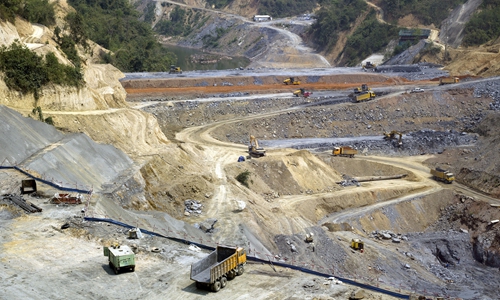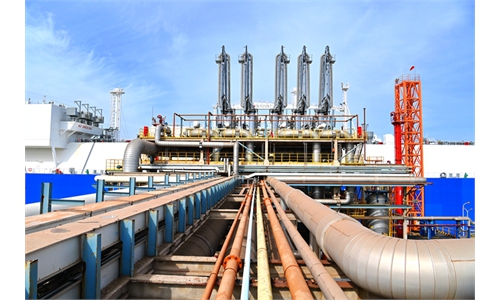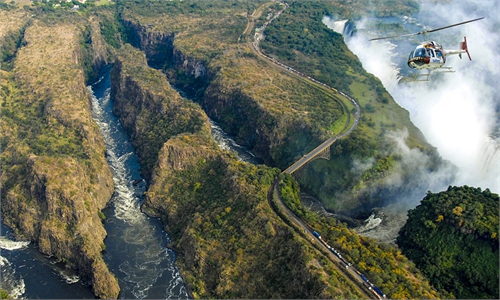
The first phase of construction on the Nam Ou Cascade Hydropower Project by Chinese corporation Sinohydro Photo: VCG
In an age when there are more voices than actions when it comes to the implementation of the global commitment to tackle the climate change, especially from developed economies, the China-proposed Belt and Road Initiative (BRI) has become the significant pillar leading the trend of a "green revolution" and has achieved historic progress for sustainable growth, analysts said.
From the big dam that helps Argentina sustain its energy supply to the hydropower station in Pakistan and the solar power installation in the deserts in the Middle East, it has been a long way for the green projects to found its root and has produced results for the benefits of the local people, economic growth and beyond.
From 2013 to 2020, China's cumulative direct investment in countries along the routes reached $139.85 billion. China and the countries along the routes have always adhered to the concepts of openness, greenness, integrity, and cooperation over the past eight years.
Despite the impact of the global pandemic on project construction and personnel exchanges, the energy industry in 2020 was the focus of the BRI investment, in which the proportion of investment in renewable energy, including solar, wind, and hydropower rose from 39 percent in 2019 to 57 percent in 2020, and has constituted a major part of China's overseas energy investment, according to media reports.
"Green has always been the background color of the Belt and Road," Luo Zhaohui, the chairman of the China International Development Cooperation Agency, addressed in a recent speech.
In Luo's speech, at the 2021 Sustainable Development Forum on September 27, he sent a clear message to the world that China will continue to improve its green and environmental cooperation policy framework, introduce green standards, release relevant documents, and promotes the establishment of multilateral cooperation platforms under the Belt and Road, analysts said.
This came just days after the pledge by Chinese leader that China will no longer build new overseas coal power projects, a solemn statement immediately received praise from the international community.
The green BRI projects has been the direct reflection of China's joint commitment of building a community of a shared future by providing impetus for the regional and global economic recovery and contribute to sustainable development, experts said.
One recent example is that the inauguration ceremony of ±660 kV HVDC Matiari-Lahore Transmission Line launching commercial operations in Pakistan was held via video link.
The project, under the China-Pakistan Economic Corridor, has attracted total investment of $1.65 billion and started construction on December 1, 2018. The successful commissioning of the project will significantly reduce the cost of power transmission, and effectively promote the improvement of people's livelihood, and support sustainable agriculture.
Another significant case is the hydropower project in Argentina, which to help the country to realize the "energy dream" of being less dependent on energy imports once it is completed.
Located on the Santa Cruz River, the Nestor Kirchner-Jorge Cepernic Hydroelectric Power Plant, the largest initiative in bilateral cooperation, began in 2013, with the aim of improving the country's energy infrastructure and satisfying the electricity needs of more than one million families, Xinhua News reported on September 27. Once the project is completed, the installed power capacity in Argentina will grow by approximately 6.5 percent.
Following the call for green and sustainable development, Chinese companies have been at the forefront of the green energy investments abroad.
Up to now, Energy China, a domestic leading energy construction conglomerate, has set up 265 overseas branches in 90 countries and regions around the world, with business covering 147 countries and regions.
But experts noted that while China has been making an increased effort to support global industrial transformation towards sustainable development, China cannot do it all by itself and a joint commitment is needed, especially from large economies such as the US.
The green investment scale of countries along the BRI routes will exceed $5 trillion in the next ten years, and the current funding gap is very large, Wu Huimin, head of the "Belt and Road" Research Center, said, noting that the international community's support, guidance and encouragement are urgently needed for more social capital support in the field of green development.
Meanwhile, experts noted that the current coal shortage is just a minor obstacle during the industrial transformation period, which will only accelerate the deployment of clean energy.
Instead, new challenges such as the inconsistency of international carbon emission standards could slow the promotion of green projects in the future, Zhang Zhongyuan, an associate research fellow with the National Institute of International Strategy of the Chinese Academy of Social Sciences, told the Global Times on Thursday.
However, since the overseas production capacity of China-invested coal power projects is no longer expanding, green energy will be the main direction of capital and resources, Zhang said, adding that as the demand for energy continues to increase after the resumption of work and production, the proportion of overseas investment in renewable energy will definitely increase.


